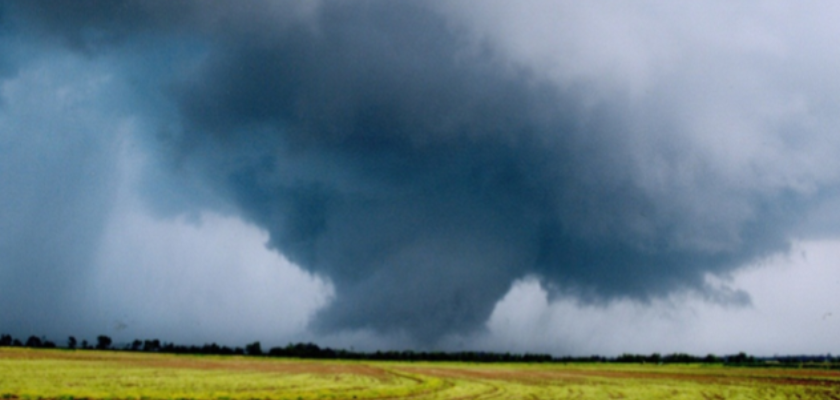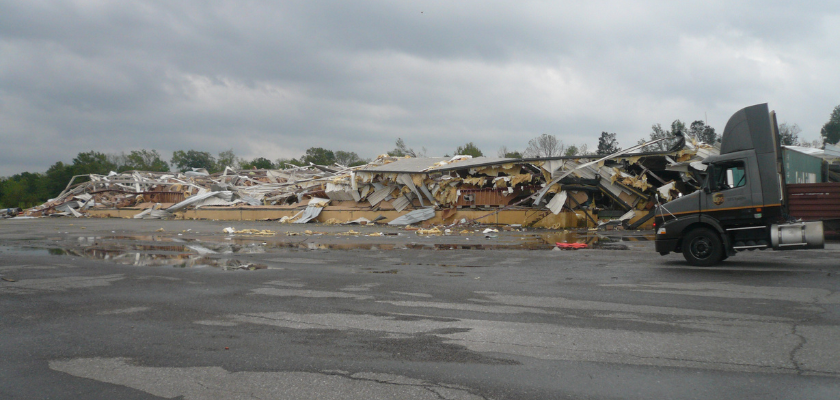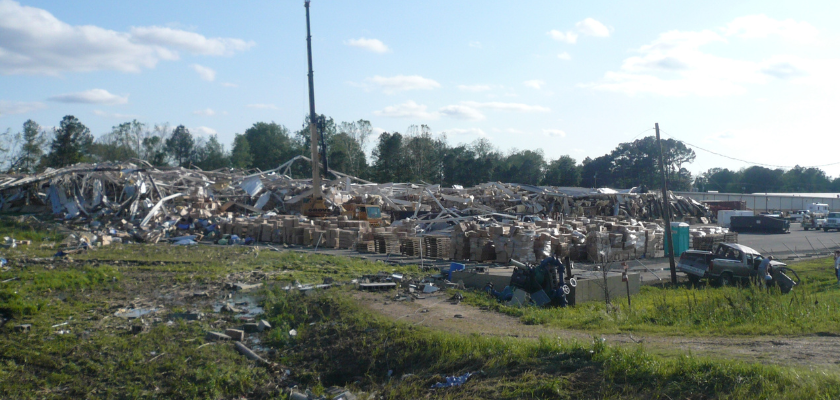
Crisis Management Insights Through the Winds of Revelation and Change
On May 2, 2008, it was a typical Friday at the headquarters of my family-owned and operated business in Earle, Arkansas—until mid-afternoon. During the afternoon we were tracking a massive storm generating tornados which was moving in our direction from the west. At approximately 3:15 pm, our world changed as an EF3 tornado (wind speeds between 136 and 165 miles per hour) slammed directly into our warehouse and distribution facility. I must admit, it was without a doubt the most frightening experience I have ever encountered. I truly did not know if I, or my company, was going to see the next day.
Fortunately, for myself and the rest of our team at the facility, we made it to see the next day. Our company survived as well, and in fact the experience set the stage for unprecedented growth of our company.
While the purpose of this article is not to rehash the experiences during the immediate moments when the tornado struck our facility, it was important to set the stage for what came both before and after. It truly was a series of new experiences, but what our company had previously done to help navigate through an event you never hope or expect to occur is what allowed us to not only survive but to flourish moving forward.
I want to share some important revelations and changes in thinking following this extraordinary event in the hope it will provide you and your organization some insight into how to best prepare for and navigate through a disaster or emergency. Managing through a crisis is never easy, but the task is certainly less daunting when you and your organization are prepared.
Have strong insurance coverage

Not until you experience an event like we did do you fully appreciate the value of a quality insurance broker and carrier who provides your company with strong and comprehensive insurance coverage. The most miserable day of your life could be when you read your insurance policy the day after a disaster and realize you may not be adequately insured, whether due to a lack of sufficient business interruption coverage or other coverage gaps in your policy.
While feverishly reading our policy coverages literally hours after our event in addition to conferring with our commercial insurance agent, you cannot imagine how relieved I was to learn that our coverage would likely put us in a good place. We had excellent coverage for this disaster. While it is certainly a challenge working through claims with any carrier, particularly with a claim as large as ours, ultimately the strength of your policy plays the most critical role in controlling the outcome. It is also important to note that you want an agent and a carrier who will be an asset during the recovery process, both immediately following a disaster and for what can be a lengthy period of time thereafter.
Protect assets, critical processes and technology

Protecting your assets and data is critical. While we were able to document most assets effectively, including millions of dollars of finished inventory that was lost or destroyed due to the tornado, this process easily could have been far more tedious had it not been for an extremely fortunate, if not miraculous event. Just prior to the tornado we were in the process of a physical inventory count which was being recorded on paper prior to being manually entered into our system. The count had been placed in a clipboard on a desk literally in the central location of where the most significant tornado damage had occurred. While everything around this desk was virtually destroyed or blown away by the tornado, the desk and clipboard were intact. It defied all reasoning. Now, the company has real time entry of inventory counts through the use of handheld scanners, something that was implemented as soon as we relocated to a new state of the art facility following the tornado.
Having adequate technology to protect your data not only in the ordinary course of business, but in the event of a disaster or an emergency, is simply not something you can ignore. Reliance on paper documents is risky business and maintaining electronic files of critical data and having such files stored securely off-site is a must. Additionally, making sure you don’t lose an ability to carry on with critical processes, such as payroll, is essential. A short-term survival strategy should be a focus of planning.
Establish a disaster recovery plan

Having a disaster recovery plan should not be an option. It is an absolute necessity to successfully navigate a disaster or emergency. While the actions noted above and below are certainly important components of a sound disaster plan, other important components must be in the plan. Having a disaster leadership team in place and clearly defining the role of the team and each of its members is an important step. This team should identify and assess disaster risks including not only natural disasters but also man-made emergencies and technology risks. Knowing who to turn to in the event of a disaster or emergency, and maintaining an updated list of contacts is also critical.
Additionally, an area that is often overlooked is not taking into consideration the impact of a potential disaster at a third-party provider. What would be alternatives in the event a third-party partner is shut down? This is an area where we lacked some clarity in our plan. It is often human nature to think a disaster will not happen at your business, and even easier to not think of one possibly occurring at a provider’s business. Well, think otherwise and always work on the assumption that at some point you likely will have to deal with some form of a disaster or emergency impacting your business. Finally, training all of your staff as well as testing and maintaining the disaster recovery plan is important to accommodate changes in your business as well as constantly evolving disaster risks.
Deal with the media

When you have a disaster of the magnitude my company experienced in 2008, it is going to attract the attention of the media, even in a small town like Earle, Arkansas. How you deal with the media, whether following a disaster or upon other material news about your company, is far more important than you might imagine. Poor messaging can have real public relations consequences.
While we certainly could have had a plan which was clearer on how to respond to media inquiries, we were fortunate that for the most part the right people in our organization were approached on-site by the media or were otherwise contacted by the media for comment. In the few circumstances where the media was able to secure comments from non-leadership members of our team, which in some cases but not all we were able to coordinate, such team members fortunately gave credible and meaningful responses. I attribute that in large part to the culture we had built within our company, a subject I will discuss below.
Reach out to third parties, including customers

When a disaster or some other form of crisis occurs, it is not always your most immediate concern to do anything but address the issue internally. For example, when I first witnessed the extensive damage that the tornado had done to one of our warehouses and knowing that there could be team members in the warehouse, I instinctively and immediately ran into the warehouse without any consideration for my own safety. In retrospect this was probably a poor decision, but in the moment, it was something I simply felt compelled to do. Should I have taken on some other responsibility at the time and have left the job of checking on possible injuries to trained first responders? The important point here, and one that is best addressed by a disaster recovery plan, is having specific roles assigned by the disaster recovery team. This would include reaching out in a timely manner to appropriate third parties such as first responders and your insurance carrier, both of whom play a critical role in disaster recovery efforts.
Additionally, while not as urgent as the immediate need to contact certain parties such as critical first responders, timely communication with others, such as customers, is very important. What we learned was that almost without exception, those with whom you transact business will exhibit a great deal of compassion and aid their business partners in a time of crisis. Our ability to ship goods was severely limited due to both facility damage and the loss of significant inventory, yet our customers were there for us. We communicated with transparency and with a willingness and determination to work through this crisis together.
Develop corporate culture

The culture of your organization can work for or against your company in the event of a crisis. While building a particular culture within an organization is certainly not specific to the need to effectively manage a crisis, when dealing with a disaster or emergency you learn just how important culture is to the outcome of a crisis. As it is said, you can focus on creating an appropriate corporate culture for your organization or one will be created for you.
While I am not here to advise on what type of culture may be best suited for your organization, a culture of integrity, transparency, working toward a common goal, empathy, etc. goes a long way in rallying the troops during a time of significant challenge. It is truly amazing what a team can accomplish when they believe they are an integral part of an important mission, and there is maybe no better way to understand or witness this than in the face of a disaster and a will to survive.
The emergence of leadership

Unquestionably, one of the most important and surprising outcomes from our disaster was the emergence of future leaders. While it should not have to happen this way, when a crisis occurs true leadership is often born. It literally took a village for our company to work through the recovery of our business. From having teams sort through thousands of cases of product stacked on our parking lot, to staff assisting with alternative shipping options and other post disaster tasks, we witnessed the emergence of several team members who exhibited skills necessary to be considered for a move into a leadership role within the company. This was one of several silver linings of our disaster. If your company encounters a crisis, do not overlook the opportunity to witness the potential emergence of future leaders for your organization.
It shouldn’t take a disaster to take appropriate actions

There were several post-disaster actions we took to take advantage of the circumstances presented by the tornado. Thanks to a strong insurance policy and a favorable settlement, our company was able to relocate to a new Class A facility specifically designed for warehousing and distribution operations. The new facility, coupled with insurance proceeds, enabled the company, among other things, to invest heavily in new technology and enhanced office, showroom, and meeting spaces, all of which played a significant role in our ability to scale.
Had we not had the tornado and had remained in the Earle facility, we would not have had the infrastructure to scale the business to where it is today. While the tornado clearly put us in a reactive mode, we later recognized that we should have been more proactive in the years leading up to 2008. The question we kept asking ourselves after settling into our new facility was, “Why didn’t we do this sooner?” Silver linings are great (if you’re lucky to have any), but so is proactivity. Make every effort to effectuate change when change is warranted and not as a consequence of a crisis.
At Lift, we are here to help with any number of challenges and opportunities that may exist for your company. It would be our honor to provide insights on how to lift your organization to new heights.
Interested in learning more about Lift? Contact us here.
